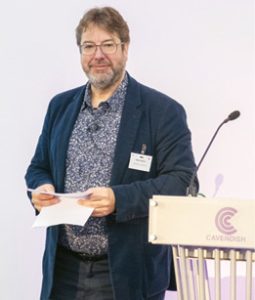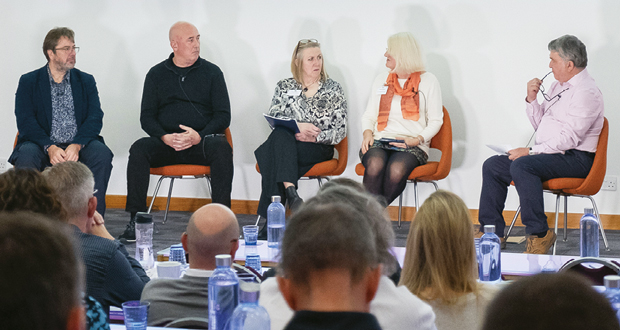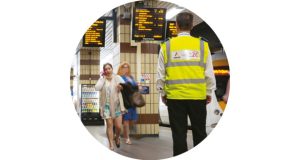Evolving ways of working was the theme of the Autumn conference from Workplace Trends, which focused on the challenges and opportunities for the post-COVID workplace
At last year’s Workplace Trends event, much of the discussion revolved around the unique opportunity being presented to workplace designers and managers to reinvent the workplace. This year’s event brought us up-to-date with how it’s all going.
We began with a real-life example, from NatWest’s Paul Urmston on how a new workspace – originally created as part of the renewal of NatWest’s head office at 250 Bishopsgate in 2019 now accommodates new ways of working. The office, with its emphasis on fluid territories that encourage human interaction, activities and views had been designed to encourage teamwork, collaboration and social activities. All ideally suit the new workplace era, where said Urnston, “people are not commuting to compute”. The space is also underpinned by seamless technology designed around mobile devices, but the human FM element is also important, with occupants supported by house community managers to help map their journey throughout the workspace.
Gary Thornton of lighting designers Nulty+ explained that attracting people back into the workplace is one of the reasons why quality lighting is ‘bleeding across’ from the hospitality sector into the workspace. “Given the amount of time we all spend of work,” he argued, “great lighting shouldn’t be confined to hospitality. Light has the power to engage employees, improve productivity and of course enhance health and wellbeing – and at the heart of this is offering people a choice.”
MEASURING CHANGE
Rather than relying on guesswork to measure engagement a new peer-reviewed framework uses Audiem’s workplace-trained analytics engine to provide insights from rich, unstructured employee feedback. Will Easton from Virgin Media O2’s new workplace experience team, was on hand to showcase how his organisation has been putting this theory into practice.
He explained: “It’s no longer about measuring satisfaction rates on a scale of one to 10 and arguing if a six is good enough, instead we can produce accurate feedback and present that to the service provider.” These insights he concluded are helping the property team make better decisions and has enhanced their creditability with the organisation’s senior leadership.
The beauty and power of great design is transforming the user experience said Gillian Stewart of Michael Laird Architects who presented a series of case studies from a variety of client sectors, encompassing workplace, leisure, higher education and food and drink.
Her case study on law firm Brodies LLP was a valuable insight into how pre-COVID design changes pre-empted the adoption of more flexible ways of working to support hybrid working patterns. This has given occupants a much greater level of choice into how and where they work and transformed the culture to one of shared knowledge and increased wellbeing.
UK office densities had gradually increased over the last 20 years or so, but recent utilisation studies show that weekly occupancy levels are at their lowest, leaving many desk and other work-settings unoccupied. Rob Harris, Ramidus Consulting chaired a discussion with Tim Oldman, Leesman; Nigel Oseland, Workplace Unlimited; Gillian Stewart, Michael Laird Architects; and Bridget Workman, The Changing Work Company to discuss the appropriate planning densities for future UK offices.
Given the changes to the way we work said Oseland requires more than just deciding on a density number, we need a set of guidelines on how we determine that right number. Oldman instead preferred the idea of measuring the quality of the employee experience.
MEASURING PERFORMANCE
Also pushing the people perspective is Peter Cheese of the CIPD in his book: ‘The New World of Work Shaping a Future that Helps People, Organizations and Our Societies to Thrive.’ “We’ve got to put people front and centre of our business thinking, which is why ideas such as compassionate management is coming to the fore,” he said, adding that the way we’re evaluated at work should not be about activity, i.e. how many hours we’ve put in rather than the outcomes created. If you can achieve the same outcome with fewer hours all the better he concluded.
Working fewer hours while retaining or even improving productivity is the premise of the four-day week pilot trials of 4 Day Week Global, explained Founder Charlotte Lockhart. She advised that an organisation already requires a good work culture so this is not a culture fix and nor is it “a bottom up process. Leaders need to sit on their hands and let their staff take it on, which this might be difficult for them to adjust to.”
Leading people through change was the theme of the final session of the day – with Jennifer Bryan, Author, and Mark Catchlove, MillerKnoll Insight Group discussing Bryan’s new book, Change and Leadership. “I call it leading people as change doesn’t happen without the people and they are the ones that own that change and will decide to what level and degree it’s going to get done.”
 Summing up the day, Chair Nigel Oseland reflected on how the world of work has had a great reset over the last two years, with a re-evaluation of the very purpose of the workplace. This has brought great changes to the way we design and manage those spaces. Encouragingly, the examples provided at this year’s conference suggest that we’re going in the right direction and it’ll be interesting to see what has been achieved when the annual event celebrates its 20th anniversary next year.
Summing up the day, Chair Nigel Oseland reflected on how the world of work has had a great reset over the last two years, with a re-evaluation of the very purpose of the workplace. This has brought great changes to the way we design and manage those spaces. Encouragingly, the examples provided at this year’s conference suggest that we’re going in the right direction and it’ll be interesting to see what has been achieved when the annual event celebrates its 20th anniversary next year.





